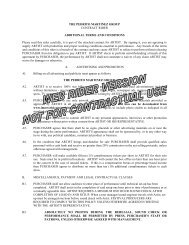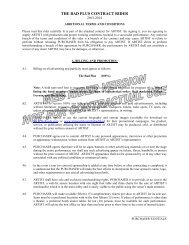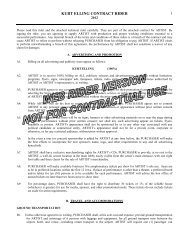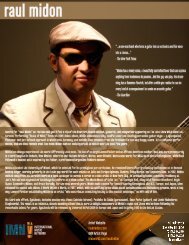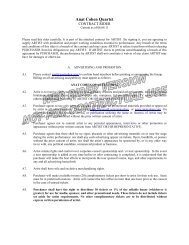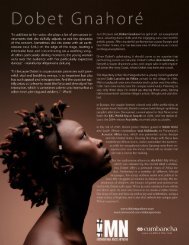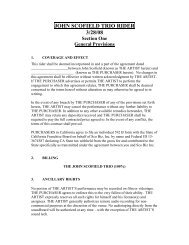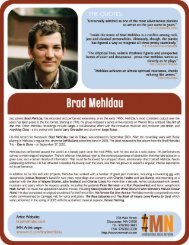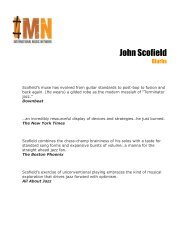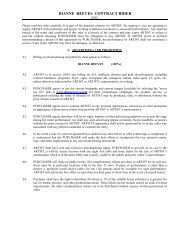McCoy Tyner Trio feat. Bill Frisell & Gary Bartz - International Music ...
McCoy Tyner Trio feat. Bill Frisell & Gary Bartz - International Music ...
McCoy Tyner Trio feat. Bill Frisell & Gary Bartz - International Music ...
- No tags were found...
Create successful ePaper yourself
Turn your PDF publications into a flip-book with our unique Google optimized e-Paper software.
mcoytynerItisnotanoverstatementtosaythatmodernjazzhasbeenshapedbythemusicoffive-timeGrammyAwardwinnerandNEAJazzMaster.Hisblues-basedpianostyle,repletewithsophisticatedchordsandanexplosivelypercusivelefthandhastranscendedconventionalstylestohisdaysasagroundbreakerwiththeclasicJohnColtraneQuartettohiscurentstatusasalivingjazzicon,hasa50-plusyearhistoryofmusicperformance.At17hebeganacareer-changingrelationshipwithMilesDavis’sidemansaxophonistJohnColtrane.<strong>Tyner</strong>joinedColtranefortheclasicalbum MyFavoriteThings(1960),andremainedatthecoreofwhatbecameoneofthemostseminalgroupsinjazzhistory,TheJohnColtraneQuartet.Theband,whichalsoincludeddrummerElvinJonesandbasistJimmyGarison,hadanextraordinarychemistry,fosteredinpartby<strong>Tyner</strong>’salmostfamilialrelationshipwithColtrane.becomeoneofthemostidentifiablesoundsinimprovisedmusic.Hisharmoniccontributionsanddramaticrhythmicdevicesform thevocabularyofamajorityofjazzpianists.Hailedglobalyasamasterpianist,jazzstylistandoneofthebestlivingcomposersofthegenre,<strong>Tyner</strong>,fromIn1965<strong>Tyner</strong>brokeoutasacomposerandbandleaderandhassincereleasednearly80albumsunderhisname(indiferentconfigurations/genres:solo,trio,bigband,Latinanddance).<strong>Music</strong>/dancecolaborationsincludeatourwithAileyIchoreographedbyTroyPowel,andengagementswithelectrifyingtapartist,SavionGlover.TVspotsincludeDavidLeterman,ConanO'Brien,andBiography’sBreakfastwiththeArts.<strong>McCoy</strong><strong>Tyner</strong>nurtureseachfacetofhispianoartwithgusto,uncompromisingintegrityandboundlesenergy.Heviewsmusicandpianoashislifepurpose,andperformingishispasion.ArtistWebsitemcoytyner.comIMNAristPage:imnworld.com/mcoytyner278MainStretGloucester,MA01930T:978.283.283F:978.283.230imnworld.comINTERNATIONALMUSICNETWORK
Reading Eagle: Ben HastyJazz legend <strong>McCoy</strong> <strong>Tyner</strong> in the Miller Center for the Arts in Reading on Saturday nightas part of the Berks Jazz Fest.CONCERT REVIEW: <strong>McCoy</strong> <strong>Tyner</strong> brings turbulence, drama to Berks JazzFestBy John FidlerReading Eagle4/4/2009Berks County, PA - When pianist <strong>McCoy</strong> <strong>Tyner</strong> and drummer Elvin Jones quit the JohnColtrane quartet in the mid-1960s, jazz critic Ben Ratliff has written, they were unable tohear themselves in the monsoon of sound.<strong>Tyner</strong> came full circle in Reading on Saturday night as he and his quartet, with guitaristDerek Trucks sitting in, created their own dramatic turbulence in the Miller Center for theArts. Their set was one of the last in the 19th annual VF Outlet Berks Jazz Fest, whichwraps up today.It is hard to avoid using the word legendary to describe <strong>Tyner</strong> (the last surviving memberof the great Coltrane foursome), and his contributions to jazz, but he is much more than alegend. His most recent album, "Guitars," <strong>feat</strong>ures Trucks and three other guitarists andbanjoist Bela Fleck. At 70, <strong>Tyner</strong> is still exploring new worlds.In one of those worlds, "Fly with the Wind," from 1976, and the opening numberSaturday night, <strong>Tyner</strong> staked his territory with his signature volcanic left hand and oceanwaves of chords in his right.
Saxophonist <strong>Gary</strong> <strong>Bartz</strong>, with his corona of white hair, joined the fray with meteoric runs,stop and start bursts and a rolling thunder that bordered on caterwauling. But howbeautiful the caterwauling was.<strong>Tyner</strong> leaves plenty of room for his bandmates to solo, and in almost every tune, bassistGerald Cannon and drummer Eric Kamau Gravatt had their turns. Their playing,insistent, urgent, impatient, left the germ of the tune behind, rendering it beside the point.The effect was of a sonic locomotive hurtling down the tracks. Woe betide the haplesslistener who got in its way.Coltrane’s "Moment’s Notice," from his seminal 1957 album "Blue Train," followed.<strong>Bartz</strong> rocketed into the stratosphere, Cannon’s bass became more than foundation andGravatt’s drumming matched <strong>Tyner</strong>’s booming block chords and thundering right-handoctaves in its searing precision.The band slowly left the stage, and in what should have been an oasis of peace as <strong>Tyner</strong>sat alone in the spotlight, an annoying hiss of feedback (a microphone left on, perhaps?)was so distracting that a listener had to fight desperately to hear the surging passionwithin the ruminative chords and the brief nod to stride piano. Problems with soundsystems have long plagued the Berks Jazz Fest. A fly buzzing around the keyboardseemed to save the number as <strong>Tyner</strong> assured the crowd, "He’s in the union!"The remaining four numbers in the set seemed to have gone without titles. I askedCannon for a set list as he packed his upright bass and he shrugged his shoulders."We forget them as soon as we play them," he said, smiling. Just as well.But a contemplative reverie formed under that soft light. <strong>Tyner</strong> referred to his wife andsaid "There’s always tomorrow." The piece unfurled gradually, mustering its own quietpropulsion and landed somewhere between contemplation and elegy.<strong>Bartz</strong> seemed to search for something elusive in his solo, exploring the center of the song,relishing the melody’s core. <strong>Tyner</strong>’s right-hand octaves left that core behind, if onlybriefly, and they dissolved back to the center of the keyboard of his Steinway concertgrand.When Trucks came onstage, the evening changed. His slide guitar evoked the greatDuane Allman, for whom Trucks’ uncle, Butch Trucks, played drums in the 1970s.Trucks and <strong>Bartz</strong> were conjoined twins as they traded eighth notes in what had the feel ofa cutting contest.<strong>Tyner</strong>’s playing at 70 remains as explosive, as nuanced and, at the right moments, astender as it was when he, Coltrane, Jones and bassist Jimmy Garrison ravaged the jazzlandscape in the early 1960s.
We need more artists like <strong>Tyner</strong> at the local jazz festival, if only to remind us what jazzreally is.
<strong>McCoy</strong> <strong>Tyner</strong> <strong>Trio</strong> <strong>feat</strong>. <strong>Bill</strong> <strong>Frisell</strong> & <strong>Gary</strong> <strong>Bartz</strong>Friday 10 July 22.30 h<strong>McCoy</strong> <strong>Tyner</strong> (piano), Gerald Cannon (bass), Eric Kamau Gravatt (drums), <strong>Bill</strong> <strong>Frisell</strong> (guitar),<strong>Gary</strong> <strong>Bartz</strong> (altsaxofoon, sopraansaxofoon, klarinet)Pianist <strong>McCoy</strong> <strong>Tyner</strong> is a bright light of the jazz scene. From an early age, he acquired areputation as the pianist with the John Coltrane Quartet, with whom he recorded many songs.Since then, he has continued to record and tour dauntlessly.Just like Coltrane, <strong>Tyner</strong> comes from Philadelphia, where he was born into a musical family. Hestarted playing the piano at the age of thirteen and after two years, he was completely underthe spell of the music. <strong>McCoy</strong> <strong>Tyner</strong> is in large part self‐taught, apart from three years of formalmusic training. But at the age of 15, he was already a developing professional. He mentions BudPowell, Thelonious Monk and Art Tatum as his first influences. He became the pianist in thefamous Jazztet of saxophone player Benny Golson. In 1959, he met saxophone legend JohnColtrane, who told him that he would soon be starting his own quartet and that <strong>Tyner</strong> was theright man for the piano chair.In 1960, at twenty two, he became a member of John Coltrane’s quartet. He was audible for thefirst time on Coltrane's famous album My Favorite Things. <strong>McCoy</strong> <strong>Tyner</strong> achieved fame playingbeside bass player Jimmy Garrison and drummer Elvin Jones. Between 1961 and 1965, hetoured almost non‐stop and collaborated on some classical albums: Live At The VillageVanguard, Ballads, A Love Supreme, Ascension. Together, they pushed back frontiers. Thisquartet had great energy and drive and produced an incredible, explosive power.During his time in the Coltrane quartet, <strong>McCoy</strong> <strong>Tyner</strong> had also begun recording his own albums,such as Inception. After he left Coltrane in 1965, he released a series of records for Blue Note,including the classic The Real <strong>McCoy</strong>. Later, he moved over to the Milestone label and recordedSahara (1972), Enlightenment (1973), and Fly With The Wind. In his music for Blue Note andMilestone, he often used the influence of Coltrane, but <strong>Tyner</strong> also dipped into African and Asianmusic. Furthermore, he likes to mix blues and Latin impressions into his music. These albumsare often mentioned as examples of essential, innovative jazz of the 1970s.<strong>McCoy</strong> <strong>Tyner</strong> churns out great chords and the rich, orchestral sound. He turns the piano into agrand, impressive instrument. His style is flowery, shamelessly romantic, vigorous, momentousand outspoken. <strong>McCoy</strong> <strong>Tyner</strong> is a master at creating contrasts. He nourishes a forceful style. Hewas able to create fireworks and intense grave sounds when playing the piano, but he was alsoa romantic. His ballads always sound very tender. <strong>Tyner</strong> is now 70 years old and an elderstatesman of jazz who likes to browse through a wide repertory.
MCCOY TYNERBiography2008-2009It is not an overstatement to say that modern jazz hasbeen shaped by the music of <strong>McCoy</strong> <strong>Tyner</strong>. His bluesbasedpiano style, replete with sophisticated chordsand an explosively percussive left hand hastranscended conventional styles to become one of themost identifiable sounds in improvised music. Hisharmonic contributions and dramatic rhythmic devicesform the vocabulary of a majority of jazz pianists.Born in 1938 in Philadelphia, he became a part of thefertile jazz and R&B scene of the early ‘50s. His parentsimbued him with a love for music from an early age.His mother encouraged him to explore his musicalinterests through formal training. The young pianist fellunder the spell of blues and bebop at an early ageleading jam sessions in his mother’s beauty shop andwinning talent shows. <strong>McCoy</strong>’s decision to study piano was reinforced when he encounteredthe legendary bebop pianist Bud Powell, who was a neighbor of the family's. Another majorinfluence on <strong>Tyner</strong>'s playing was Thelonious Monk, whose percussive attacks would inform<strong>Tyner</strong>'s signature style. As a teenager in the 50s, <strong>Tyner</strong> often found opportunities to learndirectly from other notable Philly-based musicians. He played with numerous natives of thethriving hometown jazz scene, including trumpeter Lee Morgan and the Heath Brothers,and even led his own septet.At 17 he began a career-changing relationship with Miles Davis’ sideman saxophonist JohnColtrane. While <strong>Tyner</strong> patiently waited for Coltrane to leave Miles' group and start his ownband, another saxophonist, Benny Golson invited <strong>Tyner</strong> to join him and trumpeter ArtFarmer in forming a New York-based ensemble, Jazztet.<strong>Tyner</strong> finally joined Coltrane for the classic album My Favorite Things (1960), and remained atthe core of what became one of the most seminal groups in jazz history, The John ColtraneQuartet. The band, which also included drummer Elvin Jones and bassist Jimmy Garrison,had an extraordinary chemistry, fostered in part by <strong>Tyner</strong>’s almost familial relationship withColtrane.From 1960 through 1965, <strong>Tyner</strong>’s name was propelled to international renown, as hedeveloped a new vocabulary that transcended the piano styles of the time, providing a uniqueharmonic underpinning and rhythmic charge essential to the group's sound. He performed onColtrane’s classic recordings such as Live at the Village Vanguard, Impressions and Coltrane’ssignature suite, A Love Supreme.In 1965, after over five years with Coltrane's quartet, <strong>Tyner</strong> left the group to explore hisdestiny as a composer and bandleader. But when <strong>Tyner</strong> broke out as a leader, he found thatthe American musical landscape was changing, with rock-n-roll replacing jazz as the darlingsof music consumers.1
Through faith and determination, <strong>Tyner</strong> prevailed as a soloist and sideman. Among his majorprojects is a 1967 album entitled The Real <strong>McCoy</strong>, on which he was joined by saxophonist JoeHenderson, bassist Ron Carter and fellow Coltrane alumnus Elvin Jones. His 1972 Grammyawardnomination album Sahara, broke new ground by the sounds and rhythms of Africa.Since 1980, he has also arranged his lavishly textured harmonies for a big band that performsand records when possible. In the late 1980s, he mainly focused on his regular piano trio<strong>feat</strong>uring Avery Sharpe on bass and Aarron Scott on drums. As of today, this trio is still ingreat demand. He returned to Impulse in 1995, with a superb album <strong>feat</strong>uring MichaelBrecker. In 1996 he recorded a special album with the music of Burt Bacharach. In 1998 hechanged labels again and recorded an interesting latin album and an album <strong>feat</strong>uring StanleyClarke for TelArc.<strong>Tyner</strong> has always expanded his vision of the musical landscape and incorporated newelements, whether from distant continents or diverse musical influences. More recently he hasarranged for big bands, employed string arrangements, and even reinterpreted popular music.Aside from his prodigious career as a leader, <strong>Tyner</strong> has lent his talents to a Who’s Who ofmodern jazz artists including Art Blakey, Michael Brecker, Eric Dolphy, Joe Henderson, FreddieHubbard, Bobby Hutcherson, Milt Jackson, Elvin Jones, Hank Mobley, Wayne Shorter, StanleyTurrentine, and many others.Today, <strong>Tyner</strong> has released nearly 80 albums under his name, earned four Grammys and wasawarded Jazz Master from the National Endowment for the Arts in 2002. He continuesto leave his mark on generations of improvisers, and yet remains a disarmingly modest andspiritually directed man.http://www.imnworld.com/mccoytynerhttp://www.mccoytyner.com/2
<strong>McCoy</strong> <strong>Tyner</strong>QUOTES2008-2009“Several factors enable pianist <strong>McCoy</strong> <strong>Tyner</strong> to continue his recent string of quality recordings.First, there’s the Philly-born leader’s unique vibe, formed in the crucible of the classic JohnColtrane quartet. Then there’s the exuberance of this quintet, which accomplishes more thanmerely backing up the leader.The Philadelphia Inquirer“…<strong>McCoy</strong> <strong>Tyner</strong> is hardly the prototype of a musician re-creating past hits, instead he signalsthat he still has a few surprises up his sleeve… This is yet another essential release, by thealways enjoyable <strong>McCoy</strong> <strong>Tyner</strong>.”All <strong>Music</strong> Guide“<strong>Tyner</strong> is first among equals here in a meeting of special talents.”Amazon.com“…[<strong>Tyner</strong>’s] still playing fierce, uncompromising and delightful music.”JazzTimes“…a fiery, straight-ahead set…”Ice“<strong>Music</strong>al excellence remains forever undeniable. Here it is.”OffBeat“You can hear every note in his skittering, supersonic single-note passages, and even savorthe sumptuous voice of his thickly textured chords.”Hartford Courant“…<strong>Tyner</strong>’s work always stands out, and he offers great versions of standards as well aswonderful originals. ***1/2Pittsburgh Tribune-Reviewwww.imnworld.comwww.artistwebsite.com1
The Recording Academy(R) Celebrates Classical <strong>Music</strong> and Jazz During GRAMMY(R) ...http://www.businesswire.com/portal/site/google/index.jsp?ndmViewId=news_view&news...Page 1 of 23/12/2008Search Results for GoogleSharingDiggdel.icio.usNewsvineRedditGoogleYahooPermalinkJanuary 14, 2008 07:00 AM Eastern Daylight TimeThe Recording Academy ® Celebrates Classical<strong>Music</strong> and Jazz During GRAMMY ® WeekGRAMMY Salute To Classical <strong>Music</strong> ® Honors Lang Lang and Earl WildGRAMMY Salute To Jazz ® Pays Tribute to Legends Sonny Rollins and<strong>McCoy</strong> <strong>Tyner</strong>SANTA MONICA, Calif.--(BUSINESS WIRE)--The Recording Academy ® willspotlight the classical and jazz genres with special events held duringGRAMMY ® Week. The GRAMMY Salute To Classical <strong>Music</strong> ® andGRAMMY Salute To Jazz ® events celebrate musical styles and honoreesthat have made significant contributions to our culture. Each event will<strong>feat</strong>ure live performances and a special presentation of The RecordingAcademy President's Merit Award to accomplished artists in honor of theirprofessional achievements. This year's GRAMMY Salute To Classicalhonorees are Lang Lang and Earl Wild. The GRAMMY Salute To Jazzhonorees are Sonny Rollins and <strong>McCoy</strong> <strong>Tyner</strong>. The 50th AnnualGRAMMY Awards will be broadcast live from STAPLES Center in LosAngeles on the CBS Television Network on Sunday, Feb. 10, 2008, from 8 –11:30 p.m. (ET/PT)."In continuing our 50-year history of recognizing musical excellence, we areproud to honor great talent whose artistry has helped shape and evolvethese important genres," said Neil Portnow, President/CEO of TheRecording Academy. "These events during GRAMMY Week are a truecelebration of music as they bring legends together with those that willcontinue to ensure these genres remain a vital part of our culture. We arethrilled to pay homage to such dynamic artists and celebrate their influentialmusic."GRAMMY Salute To Classical <strong>Music</strong>The GRAMMY Salute To Classical <strong>Music</strong> will honor two extraordinarypianists, Lang Lang and Earl Wild. At only 25 years old, current GRAMMYnominee Lang Lang has performed to sold-out audiences around the world.He founded the Lang Lang <strong>International</strong> <strong>Music</strong> Foundation, which isdedicated to inspiring the next generation of musicians. A GRAMMY winnerand legendary pianist, Wild became the first artist to perform a piano recitalon U.S. television. He has recorded more than 40 albums and celebrated his90th birthday in 2005 with a concert tour that culminated with a recital at
The Recording Academy(R) Celebrates Classical <strong>Music</strong> and Jazz During GRAMMY(R) ...http://www.businesswire.com/portal/site/google/index.jsp?ndmViewId=news_view&news...Page 2 of 23/12/2008PrintClose WindowCarnegie Hall in New York City.This event will take place for the first time at the renowned Walt DisneyConcert Hall on Tuesday, Feb. 5, 2008, with a reception, specialpresentation and performances by the honorees from 12 – 3 p.m. ThePresident's Merit Award for outstanding achievement will be presented tothese prolific musicians for their significant contributions to classical musicand the community at large.GRAMMY Salute To JazzLegendary jazz greats Sonny Rollins and <strong>McCoy</strong> <strong>Tyner</strong> will be honored atGRAMMY Salute To Jazz. Rollins is a two-time GRAMMY-winning tenorsaxophonist and 2004 GRAMMY Lifetime Achievement Award recipient. Heemerged at the height of the bebop jazz movement, and his illustriouscareer has consisted of more than five decades of recording. Since 2005 hehas recorded on his own record label, Doxy Records. Five-time GRAMMYwinning<strong>Tyner</strong> is a jazz pianist whose style has become one of the mostidentifiable sounds in improvised music. He has released nearly 80 albumsand in 2007 formed his own record label, <strong>McCoy</strong> <strong>Tyner</strong> <strong>Music</strong>, in partnershipwith Blue Note Records.The presentation of the President's Merit Awards to Rollins and <strong>Tyner</strong> willtake place on Tuesday, Feb. 5, 2008, from 7 – 10 p.m. at the MillenniumBiltmore Hotel in Los Angeles and will <strong>feat</strong>ure a cocktail reception, liveperformances and appearances by the honorees and the Gibson/BaldwinGRAMMY Jazz Ensembles.Established in 1957, The Recording Academy is an organization ofmusicians, producers, engineers and recording professionals that isdedicated to improving the cultural condition and quality of life for music andits makers. <strong>International</strong>ly known for the GRAMMY Awards — thepreeminent peer-recognized award for musical excellence and the mostcredible brand in music — The Recording Academy is responsible forgroundbreaking professional development, cultural enrichment, advocacy,education and human services programs. In its 50th year, The Academycontinues to focus on its mission of recognizing musical excellence,advocating for the well-being of music makers and ensuring music remainsan indelible part of our culture. For more information about The Academy,please visit www.grammy.com.ContactsThe Recording AcademyJennifer Keppel, 310-392-3777jenniferk@grammy.comTerms of Use | ©2008 Business Wire
Albany, N.Y.: Timesunion.com - Print Storyhttp://timesunion.com/AspStories/storyprint.asp?StoryID=669580Page 1 of 23/12/2008Song-and-dance menThe tunes of <strong>McCoy</strong> <strong>Tyner</strong> and the moves of Savion Glover have a certain synchronicityprint storybackBy GREG HAYMES, Staff writerClick byline for more stories by writer.First published: Thursday, March 6, 2008<strong>Music</strong> and dance have been partners since the first song set toes to tapping, and it's been a long and happy pairing of auraland visual art forms.It's not often, however, that dance becomes an actual part of the music.But that's exactly what's in store Friday at The Egg, when master jazz pianist <strong>McCoy</strong> <strong>Tyner</strong> and his trio team up with tapdance virtuoso Savion Glover."If you look back through history, most tap dancers have tapped to jazz, and the rhythmic patterns of this particular musicthat I've been involved in for all these years," says the 69-year-old <strong>Tyner</strong>, who will be joined by bassist Gerald C. Cannon anddrummer Eric Kamau Gravatt along with Glover at The Egg. "And I'm glad to see it happen again as much as possible, and theassociation has been working very well when we do get a chance to get together to perform."<strong>Tyner</strong> and Glover first performed together three years ago at the Blue Note in New York City, and they've joined forcesoccasionally for performances ever since."When we first got together it seemed to click for some reason," recalls the veteran keyboardist.SimilaritiesPerhaps one reason <strong>Tyner</strong> and Glover gel so well is that <strong>Tyner</strong>'s instrument the piano fuses together melody and rhythm in aunique fashion."The thing is that the piano is both a string and percussive instrument. You have to press the keys, and then the hammersstrike the strings. It's a very unique instrument in that sense," <strong>Tyner</strong> said."It was my only instrument when I was growing up, and I'm so glad I studied piano. I've been doing it a long time."<strong>Tyner</strong> first rose to prominence in jazz circles as the pianist with the legendary saxophonist John Coltrane's classic quartet ofthe early '60s, playing alongside bassist Jimmy Garrison and powerhouse drummer Elvin Jones. And throughout hissubsequent career as a bandleader, <strong>Tyner</strong>'s music has constantly been fueled by some of the most acclaimed and explosivedrummers, including Jones, <strong>Bill</strong>y Cobham, Tony Williams, Al Foster and Jeff "Tain" Watts.So it seems only natural that the fleet feet of Glover would provide scintillating percussive propulsion with <strong>Tyner</strong>'s music, butsurprisingly enough, <strong>Tyner</strong> doesn't necessarily hear Glover as a percussionist."I feel he's like a guy playing saxophone or something like that because he uses his feet so well," <strong>Tyner</strong> says. "Savion is like ahorn player. He's a great improviser."He hears what you're doing rhythmically, and he's very, very fluent when it comes to music. He just does it with his feet, youknow? And we connect that way, rhythmically and melodically as well because he's like an instrument. His feet are hisinstrument."
Albany, N.Y.: Timesunion.com - Print Storyhttp://timesunion.com/AspStories/storyprint.asp?StoryID=669580Page 2 of 23/12/2008Studying dance<strong>Tyner</strong> knows a thing or two about dance, as well."When I was a teenager, I affiliated myself with a dance school. I studied dance," he recalls. "At the school they needed somemale dancers, so I said, 'Let me find out what this is about.' I didn't study tap I studied African dancing but a lot of peoplewere interested in tap. It's a very rhythmic concept tapping. It's definitely part of the African-American experience and theAmerican experience as well."So I connected with Savion right away. He sort of brought back some wonderful memories. It has a lot to do with the musicjazz and tap just go together."It's a beautiful thing. I found out that dance and jazz music are like bedfellows they're so wonderful when they'recoordinated."Throughout his long career, <strong>Tyner</strong> has recorded more than 80 albums in his own name, including his latest CD, simply titled"The <strong>McCoy</strong> <strong>Tyner</strong> Quartet," which he released late last year to launch his own record label <strong>McCoy</strong> <strong>Tyner</strong> <strong>Music</strong>.The next album from the new label is slated for release in the fall, a CD/DVD package which not only <strong>feat</strong>ures <strong>Tyner</strong> and therhythm section of bassist Ron Carter and Woodstock drummer Jack DeJohnette, but also an array of special guest guitaristsMarc Ribot, Derek Trucks, John Scofield and <strong>Bill</strong> <strong>Frisell</strong>, as well as banjo pioneer Bela Fleck.But <strong>Tyner</strong> doesn't spend a lot of time planning his next musical moves. "I take it one step at a time. I don't want to get too farahead of myself," he says. "I enjoy each day, and every day is different. I learn that way. I appreciate the moment."You have to improvise," he adds. "I think that's what I do best."Greg Haymes may be reached at 454-5742 or by e-mail at ghaymes@timesunion.com.The <strong>McCoy</strong> <strong>Tyner</strong> <strong>Trio</strong>With: Savion GloverWhen: 8 p.m. FridayWhere: The Egg, Empire State Plaza, AlbanyTickets: $36; seniors $32; children $18Info: 473-1845; http://www.theegg.orgAll Times Union materials copyright 1996-2008, Capital Newspapers Division of The Hearst Corporation, Albany, N.Y.HOME | CONTACT US | SUBSCRIBE TO NEWSPAPER | HOW TO ADVERTISE | PRIVACY RIGHTS | COPYRIGHT | CLASSROOM ENRICHMEN
NJ.com's Printer-Friendly Pageof 2http://www.nj.com/printer/printer.ssf?/base/entertainment-1/120391773...3/12/2008 9:56 AMTap master add his beat to jazz trioMonday, February 25, 2008ROBERT JOHNSONSavion Glover and <strong>McCoy</strong> <strong>Tyner</strong>Where: Count Basie Theatre, 99 Monmouth St., Red BankWhen: 8 p.m. FridayHow much: $45-$100. Call (732) 842-9000 or visit countbasietheatre.org.Tap dance genius Savion Glover never seems to run out of ideas. Rhythms cascade from his feet incontinuous and unpredictable streams, but, more than that, he keeps finding new ways to frame what hedoes so that it always looks fresh.The dancer's current tour, in which he appears as the guest of celebrated jazz pianist <strong>McCoy</strong> <strong>Tyner</strong> and his<strong>McCoy</strong> <strong>Tyner</strong> <strong>Trio</strong>, is simply the latest in a series of remarkable encounters that have raised the profile oftap dancing while underscoring Glover's artistry and his seriousness of purpose.The ongoing dialogue that Glover and <strong>Tyner</strong> began two years ago, and brought to the Rutgers Center forthe Arts in Camden on Saturday, is less daring in some ways than Glover's past exchanges. Never afraid toprovoke or to experiment, Glover has jammed with a classical string ensemble, with classical and moderndancers, and with Bobby McFerrin. His collaboration with <strong>Tyner</strong> is something new again. It does not seek todazzle with conceptual chutzpah, nor endear itself with sheer adorability.Instead, Glover and <strong>Tyner</strong> offer audiences an evening of concentrated artistry, replete with the music'sinherent dignity and elegance. <strong>Tyner</strong>'s own music dominates the sets, giving Glover his theme, and abackdrop in a vivid shade of magenta or blue seems the artists' only concession to theatricality.The music is exciting enough. <strong>Tyner</strong> has earned his reputation for boldness, slamming the keyboard withthe palm of his hand in a way that may or may not equate Glover's penchant for funky stomping (here littlein evidence). The pianist opens the program with an impassioned number that proudly exposes histechnique and generates magnificent, floating billows of sound, colored textures that are still hanging in theair when Glover steps onto a raised platform center-stage. The tapper uses the powerful clarity of hisrhythms to cut through them, piercing the impressionistic sheets like a floodlight scanning the heavens on anight of violent electrical storms.In this remarkable percussive duet, piano and feet are sufficiently different that each artist maintains his owndistinct sphere and approach. <strong>Tyner</strong> is not to be trifled with, however, and Glover, who keeps his head andbody angled toward the piano during most of the program, seems to follow more than he leads, askingrhythmic questions and amplifying the musical context, but mostly agreeing with <strong>Tyner</strong>'s points. He seemsfreer in his relatively brief exchanges with trio members Eric Gravatt (drums) and Gerald C. Cannon (bass);and when, in part two, the conversation turns to Duke Ellington, Glover's feet have a lot to say.Ellington's "In a Mellow Tone" supplies the crisp and classic segment of a program where the musical moodevolves subtly from drama to romance and onward to the exotic, without overstepping <strong>Tyner</strong>'s personalstyle. Yet <strong>Tyner</strong> reaches out to Glover, also, especially near the official end of the program (not theindispensable encore) where the pianist captures one of Glover's beats and hammers it into his own score.Sitting back from his keyboard, and pointing a finger playfully at his tap-dancing accomplice, the pianistcould be taken for a dancer, too.Robert Johnson writes about dance for The Star-Ledger. He may be reached at rjohnson@starledger.com.
Jazz | JazzTimes Magazine > Reviews > Concert Reviewshttp://www.jazztimes.com/reviews/concert_reviews/detail.cfm?article=10291Page 1 of 312/17/2004Subscribe now | Site MapColumns & Features | Jazz Guides | Reviews | Shopping | TravelYour location: JazzTimes.com > Reviews > Concert ReviewsConcert ReviewsLatest ReviewsArchivesDec 12Nov 20Nov 20Nov 12Nov 6Nov 4Oct 30Oct 29Oct 22Oct 21<strong>Tyner</strong>, Clarke &Cobham at the BlueNoteBallard JazzFestivalBoney James andNorman BrownOrnette Colemanin Los AngelesUniversity ofPittsburgh JazzConcertPaula WestSwings theAlgonquinThe RevolutionContinuesPascoal &Baptista RouseJ@LC"Speaking ofJazz," J@LC'sAllen RoomGrand OpeningDizzy’s ClubCoca-Cola GrandOpening<strong>Tyner</strong>, Clarke & Cobham at the Blue NoteArtist(s): <strong>McCoy</strong> <strong>Tyner</strong>, Stanley Clarke & <strong>Bill</strong>y CobhamVenue/ Blue NoteLocation: New York, New York USADate: December 12, 2004Written By: Ashley KahnWhat would they play? Would theyplug in? In my mind the notion ofthe tight, sold-out quarters of theBlue Note turning into a pressurecooker of fusion-era amplificationhad me enthralled -- and scared. Butwhen I spied an acoustic bass beingheld aloft and maneuvered towardthe stage by a young man wholooked curiously like a teenagedStanley Clarke (turns out it was his son), I put the earplugsaway and got ready.I mean, come on! <strong>McCoy</strong> <strong>Tyner</strong> and <strong>Bill</strong>y Cobham and astand-up bass playing Stanley Clarke? When I first saw thegig mentioned in the Blue Note’s ad, it didn’t read like ausual weeklong residency in New York City. It read morelike a one-time festival concert. It read like something thatwould meet for the first time on Tuesday and develop overthe week -- that I should make the Sunday show if Iwanted to catch them full throttle. And it also read likehistory. Cobham had not played with <strong>Tyner</strong> -- on stage orin studio -- since the pianist’s 1976 soloists-and-stringsalbum Fly With the Wind. Clarke, normally ensconced inLos Angeles doing session work for soundtracks, wasinspired by his week in Manhattan to consider spendingmore time in New York City to get back into the giggingscene.printe-ma
Jazz | JazzTimes Magazine > Reviews > Concert Reviewshttp://www.jazztimes.com/reviews/concert_reviews/detail.cfm?article=10291Page 2 of 312/17/2004When the three virtuosi stepped on stage they weregreeted with thunderous applause; they wasted no timelaunching into displays of prowess for which each islegendary, though the performance was more dialog-drivenand interactive than showy.<strong>Tyner</strong>’s modal workout “Trane-Like” (from the Telarc albumhe did in 2000 with Clarke and Al Foster) was the first tuneoffered, played at a brisk tempo with ample room for solos-- allowing all to warm up, flex fingers and get in sync witheach other. <strong>Tyner</strong>’s crisp, single-note lines spun andspiraled, and Cobham’s melodic use of the entire drum kitwas a marvel of intuitive orchestration. But it was Clarke’srichly textured approach that caught most of the audienceunaware. From the first tune on, he attacked each solowith gusto and delight: hopping between funky, legatoplaying and his patented blurred-fingers technique at thetop of the fretboard with an almost electric-bass tone.It was obvious <strong>Tyner</strong> -- who struggled with the club’s pianoand wasn’t happy about it -- was calling the shots: “ComeRain or Come Shine” was the pianist’s choice for anevocative ballad. Bass and drums had an Afro-Caribbeandialogue next -- Clarke setting up a rhythm, Cobhamproviding a second rhythmic layer with shaker/mallets onthe toms -- which developed into the Latin-flavored“Angelina” (off Illuminations, another recent <strong>Tyner</strong> title)that <strong>feat</strong>ured flamenco-flavored strumming from Clarke.Especially on that number, the use and masterful control ofdynamics by all was astounding (and made sure theearplugs remained pocketed.)The hard-boppish “Steppin’” was kicked off by a Cobhamexplosion on cymbals and toms, and then it was <strong>Tyner</strong>’sturn to shine again, creating an improvisation thatsurprised with hints of stride devices and teases of Tatumlikeruns. Cobham’s four-stick solo -- two in each hand at90-degree angles -- brought the tune to a close.Ads byClarkDiscousedSearcbolanwww.eJazzSherSheraHoteJazz,Spa,www.sFreeDow12 BiNo D100%Favoi<strong>Music</strong>LiveMusiJazzoccasWeddrecepFloridwww.s<strong>Tyner</strong> calls the blues the “real national anthem,” and everytime I’ve caught him recently he closes with one. Clarketook full advantage of the form, improvising -- evenbending the strings -- as if he was working a club onChicago’s south side.Suddenly it was over. No encore, lights up, another showto seat. The air of expectation helped make the 55-minuteset seem like five.All later said they were ecstatic about how their music andinterplay had developed over the week, and they arelooking forward to the week they’ll spend together atYoshi’s in Oakland in January. Might this trio record



